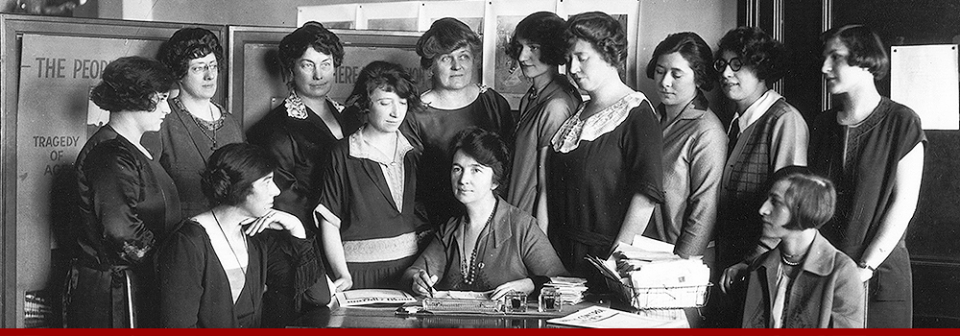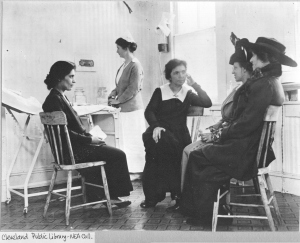On October 16, 1916, Margaret Sanger opened the first birth control clinic in the United

Sanger in 1917 (courtesy of the Library of Congress.
States. The Brownsville clinic violated Section 1142 of the New York State Penal Code. This state law, similar to the federal Comstock Law, criminalized the distribution of materials on contraception due to their obscene nature. But Sanger’s violation of the state’s anti-obscenity statute was no mistake; it was a deliberate decision meant to capture the media’s attention and push the obscure topic of birth control into public debate.
At 46 Amboy Street, Sanger’s clinic was located in the Brownsville section of Brooklyn—a densely populated, impoverished area. The men and women who lived in Brownsville were primarily working class immigrants, a socioeconomic group that, in Sanger’s eyes, was most in need of access to birth control. To advertise the clinic’s services, Sanger produced trilingual leaflets written in English, Yiddish, and Italian. They read: “Mothers! Can you afford to have a large family? Do you want any more children? If not, why do you have them? Do not kill, Do not take life, but Prevent. Safe, Harmless Information can be obtained of trained Nurses at 46 Amboy Street…All Moth
ers Welcome” (“Flyer for 46 Amboy Street Birth Control Clinic,” Sophia Smith Collection, Smith College, N.Y., n.d.)

Fania Mindell (right) and Sanger at Clinic, October 1916
Her efforts were successful. On its opening day, 140 women visited the clinic. For the nine days it remained open, the clinic had a total of 450 visitors, and many of the women seen offered testimonials. One mother shared, “This is the kind of place we have been wanting all the time. I have had seven children, two are dead, and my husband is a sick man. Do you know how I got bread for them? By getting down on my knees and scrubbing floors for the baker; that’s what I did when we couldn’t pay the bill. Seven children…that’s enough for any woman.” Another simply commented, “It is so much easier to talk to a woman than a man” (Sanger, “A Day with Margaret Sanger in her Birth Control Clinic,” Brooklyn Daily Eagle, 24 October 1916, 4).
The popularity of the Brownsville clinic came despite Sanger’s inability to secure a doctor. With no physician willing to provide contraceptive services, the social activist operated the clinic with her sister Ethel Byrne, a registered nurse, and the help of Fania Mindell, a friend and translator. Traffic and testimonials were not enough to keep the doors of the Brownsville clinic open though. On October 26, 1916 New York police shut down the country’s first birth control clinic before it had even been open for two weeks.
During the arrest of Sanger, Byrne, and Mindell, the three women resisted, creating a scene to publicly expose their violation of the law. In the trials that followed, Sanger obtained the platform she had been seeking. Her sister Ethel Byrne, convicted and sentenced to thirty days imprisonment in January 1917, immediately began a hunger strike—the dramatic protest attracting crowds of reporters. Sanger, commenting on her sister’s behavior, explained, “These unfortunate women go to their graves unnoticed and their agonies and deaths unknown. Mrs. Byrne feels that one more death laid at the door of the government of this state is of little consequence.” Byrne lasted five days before prison staff force-fed her through a tube, but the media her protest attracted was invaluable to their cause (Sanger, “Stirring Appeal Written by Birth Control Advocates,” Wilkes Barre Times-Leader, 27 January 1917, 13).
Following Byrne’s hunger strike, Sanger employed her trial as another media opportunity. During her hearing, she attempted to break the link many people saw between birth control and morality. As an alternative, Sanger advocated for the association between birth control and socioeconomic and medical issues. She called upon twenty-five Brownsville women as witnesses to garner support for her convictions. Her former patients elicited sympathy as they shared tragic accounts of failed abortions, miscarriages, and an endless series of childbirths.

Movie recreation of Sanger’s arrest at Brownsville Clinic (Courtesy of Library of Congress)
On February 2, 1917, Sanger was offered a suspended sentence if she would promise to abide by the law. The activist declined, proclaiming, “With me it is not a question of personal imprisonment or personal disadvantage. I am today and have always been more concerned with changing the law and the sweeping away of the law, regardless of what I have to undergo to have it done,” later reiterating to the court, “I cannot respect the law as it exists today.” As a result, Sanger was convicted and sentenced to thirty days of imprisonment at the Queens County Penitentiary—yet another media boon (Sanger qtd. in “Sanger on Trial: The Brownsville Clinic Testimony,” Margaret Sanger Papers Project, Newsletter, Fall 2000 and Sanger, “Liberty Scorned by Mrs. Sanger,” New York Tribune, 6 February 1917, 9).
Sanger went on to appeal the court’s decision, defending her violation of the law by pointing out its humanitarian purpose. While Sanger’s conviction was upheld, the Brownsville clinic trials led the court to “sufficiently broaden its interpretation of the law to enable physicians to prescribe birth control to women when medically indicated.” This legal shift was the first in a series of changes that would foreshadow systematized, physician-staffed birth control clinics in the U.S. (“Seventy-Fifth Anniversary of the Brownsville Clinic,” Margaret Sanger Papers Project, Newsletter, Winter 1991).
Following the 1916 Brownsville clinic and the legal wake it produced, Sanger went on to establish the American Birth Control League in 1921 and the Birth Control Clinical Research Bureau (BCCRB) in 1923. The BCCRB, like the Brownsville clinic, was another first for the United States; it was the country’s first legal birth control service provider. One year after opening its doors, the BCCRB was one of the most popular birth control clinics in the country. Fifteen years later, the BCCRB merged with the American Birth Control League. The resultant group was known as the Birth Control Federation of America. In 1942, the Federation changed its name and became known as Planned Parenthood Federation of America.
Today, the country’s relationship with birth control—one in which we are just as likely to see a television commercial for birth control pills, vaginal rings, or condoms air as we are for the local car dealership—is dramatically improved. No longer a taboo topic hiding in the shadows, birth control is a part of the public conversation and widely accessible to women of different socioeconomic backgrounds. In 1916, Sanger, Byrne, and Mindell began a century-long process; their actions ignited a series of changes in how the public would regard contraceptives and how the law would increasingly allow for birth control services. One hundred years later, we have these three strong women to thank for the advancement of our country’s relationship with birth control services.









